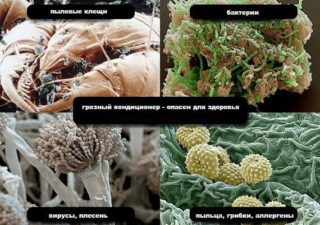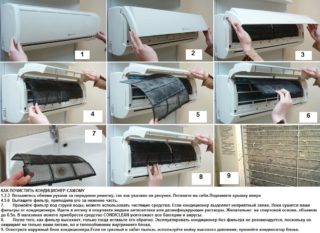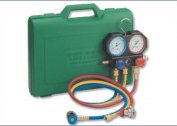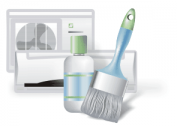Any technique requires care. Maintenance of the air conditioner extends the service life and helps to maintain the health of the residents of the apartment. The main procedure, which is carried out more often than others, is the cleaning of the indoor unit from accumulated dust. This is a simple action algorithm that you can do yourself.
5 reasons to clean your air conditioner at home
 The air conditioner should be cleaned at the time indicated by the manufacturer in order to avoid negative consequences:
The air conditioner should be cleaned at the time indicated by the manufacturer in order to avoid negative consequences:
- A dirty filter located under the front decorative panel reduces system performance. The device will not be able to work as efficiently as the new one. The load on the compressor increases, which quickly leads to breakdowns and repairs, since it does not cool completely due to a dirty fan.
- The environment in the inner block promotes the propagation of Legionella bacteria, causing severe damage to the respiratory organs, urinary and nervous systems. You can get sick even with physiotherapeutic procedures aimed at improving the health of a person. However, more often the cause is air conditioning in the house. The split system works on the principle of returning the air taken in the room, therefore, microbes enter the air from the indoor unit.
- The drainage system clogs up - the liquid cannot exit through the tube and flows through the indoor unit onto the walls. This threatens to repair the air conditioner and the room itself.
- Washing home air conditioners prevents the appearance of odors when the device is working, associated with the waste products of microorganisms.
- The closer to the road or trees the external block is located, the faster it is clogged with down, dust, branches.
If the device only works in the summer season, it is recommended that you wash the filters yourself at least once a month, because this is not part of the service. If there is a smell, you can use special antibacterial compounds that are sprayed onto a working fan of the indoor unit. Specialized companies can perform maintenance, but elementary measures are cheaper to do with one's own hand.
The help of specialists may be needed to check the system completely and refill freon.
Cleaning the air conditioner indoor unit
To get to the internal parts, you need to lift the front panel and disassemble the air conditioner for cleaning. You will need:
- a vacuum cleaner to blow dust from the inside;
- detergents purchased at a hardware store that are suitable for metal parts;
- chlohexidine for disinfection is sold at the pharmacy;
- rag.
- The strainer located immediately behind the front panel is removed and soaked in soapy water. This procedure is carried out every three weeks regularly. It takes 15 minutes along with drying and refitting. It is desirable to dry in the sun, as the sun's rays kill bacteria and fungus.
- If dirt particles get on the internal fan, the detergent solution is applied to the blades. You can just rinse them several times with warm water. A more radical method is to cover the outlet with a rag and turn on the air conditioner at low speed. Dirt will fly out from the inside and remain on a rag. A vacuum cleaner will help here, with which the dust is first cleaned, and then washed with a solution.
- The next step is to get to the condenser tank. The main thing is not to damage the drain pipe located at the other end of the tank.All manipulations are carried out carefully so as not to damage the plastic decorative panel. The tank is cleaned of dust.
- An impeller is located behind the tank - it also needs to be vacuumed with a special narrow nozzle, which is used to clean furniture in the recesses.
While internal cleaning is in progress, the filter is air dried. Next, everything is collected in the reverse order. Chlorhexidine is mixed with alcohol: 1 bottle of the substance and 100 ml of alcohol. The mixture is poured into a spray bottle. The air conditioner is turned on at low power and the substance is evenly sprayed on the surface of the fan and filter. The smell disappears within 15 to 20 minutes. Cleaning the air conditioner with chlorhexidine is the safest non-toxic method used in children’s rooms.
Internal latches are made of plastic, so inaccurate opening and closing can damage them.
Cleaning the outdoor unit
The external unit is washed independently if it is located in an accessible place. Otherwise, you need to call the altitude. The outdoor unit is cleaned once a season. Lack of service at least once a year reduces the performance of the air conditioner.
The procedure for cleaning the air conditioner with your own hands:
- Turn off the equipment, unplug the plug.
- Use a wet cloth to clean the outside of the outdoor unit.
- Remove the protective grill and vacuum all accessible parts very carefully, as they are covered with a protective layer. If it is damaged, rust will begin to form and the equipment will quickly become worthless.
- Using a hose connected to the tap, flush the insides with pressure.
- Assemble and bolt the external grille.
When working with an external device, you need to pay attention to the condition of copper pipes. If they freeze (there is frost), then there is a leak of freon, and you need to call specialists for repair and refueling. Refrigerant losses of up to 8% per year are normal. Normally, there should be no signs of ice.
Flushing the drainage system
A break in the operation of the device may cause clogging of the drainage tube and leakage of condensate through the indoor unit. Do-it-yourself cleaning of the split system also involves flushing the drainage device. It is clogged with garbage, insects build nests there for the winter. Such a cork can cause stagnation of liquid and its draining on the walls.
For washing, soap solutions and special substances that dissolve organic matter are used. Solutions under pressure are poured into the tube and then with the help of a long probe, they are removed along with the garbage.
Cleaning products

Antibacterial cleaners are designed to disinfect the inside of the air conditioner. They are sold in aerosols, therefore they are convenient to use - they create a strong pressure that penetrates deeply.
Foam solutions are designed to clean the heat exchanger. Easy to apply, then go into a liquid state. They are washed off with water or wiped with a rag, depending on the instructions in the instructions.
Means contain chlorine, alcohol, weak active substances, acids. Differ in purpose. Some substances can be harmful, therefore it is allowed to use them when there are no people in the room. The person who carries out the cleaning puts on protective gloves and a mask covering the respiratory organs. This applies to acid-containing agents. In children's rooms, the use of chemicals is not recommended.
After applying the chemicals, turn on the air conditioner to ventilate the indoor unit well and remove volatiles.
Together with cleaners, anti-corrosion agents are used. Especially useful if the air conditioner is installed on a busy street.Car gases contain substances that destroy a thin layer of protection, so it is periodically restored with acrylic-based products that extend the life of the external device.
How often should the climate system be cleaned?
It is customary to inspect and, if necessary, clean the device before the start of the summer season and in the fall. Twice a year, a full technical inspection and maintenance of air conditioners is carried out.
Once every three weeks it is recommended to rinse the strainer. If it is clean and often cleaned in the room, preventive measures can be taken once a month and a half. Of great importance is the state of fine filters. If they become clogged, it is better to replace them with new ones.
It is recommended to see once how a specialist conducts washing the air conditioner. Then you can carry out cleaning activities yourself.




